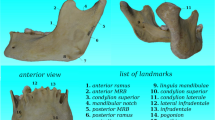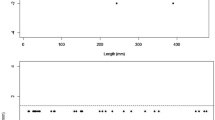Abstract
The present study aimed to evaluate the accuracy of mandibular measurements for sex determination in a Brazilian population. The sample was composed of 100 mandibles, of which 53 were female and 47 were male, and the average age was 57.03 years. The mandible measurement protocol was composed of 15 measurements, of which six were bilateral and nine were unique. Mandibles were directly measured using a digital caliper and a protractor. The descriptive analysis of the present study revealed higher mean values for male mandibles compared to those for female mandibles with the exception of the left mandibular angle. Among the 21 measures analyzed in this group, 15 were statistically significant (p < 0.05). Univariate discriminant analyses produced a mean percentage of correct predictions that varied between 49 and 79%. The association of variables increased the percentage of correct prediction of sex to vary from 76 to 86%. The receiver operator characteristic (ROC) curve analysis indicated that the best variable for estimating sex was bigonial breadth (BGB; area under the ROC curve (AUC) = 0.764) followed by the right maximum ramus height (MRHr; AUC = 0.763). A reference table for estimating sex in a Brazilian population using mandible measurements was developed based on the ROC curve analysis. Mandibular measures provide a simple and reliable method for sex discrimination in Brazilian adults due to the sexual dimorphism revealed by analysis of the metric variables and the satisfactory results demonstrated by discriminant formulas, ROC curve analysis, and the reference table.



Similar content being viewed by others
References
Krishan K, Chatterjee PM, Kanchan T, Kaur S, Baryah N, Singh RK (2016) A review of sex estimation techniques during examination of skeletal remains in forensic anthropology casework. Forensic Sci Int 261:165.e161–165.e168. https://doi.org/10.1016/j.forsciint.2016.02.007
Plavcan JM (2001) Sexual dimorphism in primate evolution. Am J Phys Anthropol 116(S33):25–53. https://doi.org/10.1002/ajpa.10011
Frayer DW, Wolpoff MH (1985) Sexual dimorphism. Annu Rev Anthropol 14(1):429–473. https://doi.org/10.1146/annurev.an.14.100185.002241
Torimitsu S, Makino Y, Saitoh H, Sakuma A, Ishii N, Yajima D, Inokuchi G, Motomura A, Chiba F, Yamaguchi R, Hashimoto M, Hoshioka Y, Iwase H (2015) Morphometric analysis of sex differences in contemporary Japanese pelves using multidetector computed tomography. Forensic Sci Int 257:530.e531–530.e537. https://doi.org/10.1016/j.forsciint.2015.10.018
Franklin D, Cardini A, Flavel A, Marks MK (2014) Morphometric analysis of pelvic sexual dimorphism in a contemporary Western Australian population. Int J Legal Med 128(5):861–872. https://doi.org/10.1007/s00414-014-0999-8
Franklin D, Cardini A, Flavel A, Kuliukas A (2013) Estimation of sex from cranial measurements in a Western Australian population. Forensic Sci Int 229(1–3):158 e151–158 e158. https://doi.org/10.1016/j.forsciint.2013.03.005
Saini V, Srivastava R, Rai RK, Shamal SN, Singh TB, Tripathi SK (2011) An osteometric study of northern Indian populations for sexual dimorphism in craniofacial region. J Forensic Sci 56(3):700–705. https://doi.org/10.1111/j.1556-4029.2011.01707.x
Ekizoglu O, Hocaoglu E, Inci E, Can IO, Solmaz D, Aksoy S, Buran CF, Sayin I (2016) Assessment of sex in a modern Turkish population using cranial anthropometric parameters. Legal Med 21:45–52
Giles E (1964) Sex determination by discriminant function analysis of the mandible. Am J Phys Anthropol 22(2):129–135. https://doi.org/10.1002/ajpa.1330220212
Kharoshah MA, Almadani O, Ghaleb SS, Zaki MK, Fattah YA (2010) Sexual dimorphism of the mandible in a modern Egyptian population. J Forensic Legal Med 17(4):213–215. https://doi.org/10.1016/j.jflm.2010.02.005
Dong HM, Deng MH, Wang WP, Zhang J, Mu J, Zhu GH (2015) Sexual dimorphism of the mandible in a contemporary Chinese Han population. Forensic Sci Int 255:9–15. https://doi.org/10.1016/j.forsciint.2015.06.010
Martin DC, Danforth ME (2009) An analysis of secular change in the human mandible over the last century. Am J Hum Biol 21(5):704–706. https://doi.org/10.1002/ajhb.20866
Martin ES (1936) A study of and Egyptian series of mandibles, with special reference to mathematical methods of sexing. Biometrika 28:149–178
Carvalho SPM, Brito LM, de Paiva LAS, Bicudo LAR, Crosato EM, de Oliveira RN (2013) Validation of a physical anthropology methodology using mandibles for gender estimation in a Brazilian population. J Appl Oral Sci 21(4):358–362. https://doi.org/10.1590/1679-775720130022
Tunis TS, Sarig R, Cohen H, Medlej B, Peled N, May H (2017) Sex estimation using computed tomography of the mandible. Int J Legal Med:1–10. https://doi.org/10.1007/s00414-017-1554-1
Cattaneo C (2007) Forensic anthropology: developments of a classical discipline in the new millennium. Forensic Sci Int 165(2–3):185–193. https://doi.org/10.1016/j.forsciint.2006.05.018
Kranioti E, Paine R (2011) Forensic anthropology in Europe: an assessment of current status and application. J Anthropol Sci 89:71–92. https://doi.org/10.4436/jass.89002
Milroy CM (1999) Forensic taphonomy: the postmortem fate of human remains. BMJ 319(7207):458–458
Standring S (2008) Gray’s anatomy—the anatomical basis of clinical practice, 40th edn. Churchill Livingstone, London
İlgüy D, İlgüy M, Ersan N, Dölekoğlu S, Fişekçioğlu E (2014) Measurements of the foramen magnum and mandible in relation to sex using CBCT. J Forensic Sci 59(3):601–605. https://doi.org/10.1111/1556-4029.12376
Sharma M, Gorea RK, Gorea A, Abuderman A (2016) A morphometric study of the human mandible in the Indian population for sex determination. Egypt J Forensic Sci 6(2):165–169. https://doi.org/10.1016/j.ejfs.2015.01.002
Vinay G, Mangala Gowri SR, Anbalagan J (2013) Sex determination of human mandible using metrical parameters. J Clin Diagn Res 7(12):2671–2673. https://doi.org/10.7860/JCDR/2013/7621.3728
Sierp I, Henneberg M (2015) The difficulty of sexing skeletons from unknown populations. J Anthropol 2015:13. https://doi.org/10.1155/2015/908535
Franklin D, O'Higgins P, Oxnard CE (2008) Sexual dimorphism in the mandible of indigenous South Africans: a geometric morphometric approach. S Afr J Sci 104:101–106
Oettlé AC, Pretorius E, Steyn M (2005) Geometric morphometric analysis of mandibular ramus flexure. Am J Phys Anthropol 128(3):623–629. https://doi.org/10.1002/ajpa.20207
Nicholson E, Harvati K (2006) Quantitative analysis of human mandibular shape using three-dimensional geometric morphometrics. Am J Phys Anthropol 131(3):368–383. https://doi.org/10.1002/ajpa.20425
Walker PL (2008) Sexing skulls using discriminant function analysis of visually assessed traits. Am J Phys Anthropol 136(1):39–50. https://doi.org/10.1002/ajpa.20776
Ogawa Y, Imaizumi K, Miyasaka S, Yoshino M (2013) Discriminant functions for sex estimation of modern Japanese skulls. J Forensic Legal Med 20(4):234–238. https://doi.org/10.1016/j.jflm.2012.09.023
Gapert R, Black S, Last J (2009) Sex determination from the foramen magnum: discriminant function analysis in an eighteenth and nineteenth century British sample. Int J Legal Med 123(1):25–33. https://doi.org/10.1007/s00414-008-0256-0
Franklin D, Freedman L, Milne N (2005) Sexual dimorphism and discriminant function sexing in indigenous South African crania. HOMO J Comp Hum Biol 55(3):213–228
Dayal MR, Spocter MA, Bidmos MA (2008) An assessment of sex using the skull of black South Africans by discriminant function analysis. HOMO - Journal of Comparative Human Biology 59(3):209–221. https://doi.org/10.1016/j.jchb.2007.01.001
Guyomarc’h P, Bruzek J (2011) Accuracy and reliability in sex determination from skulls: a comparison of Fordisc® 3.0 and the discriminant function analysis. Forensic Sci Int 208(1–3):180.e181–180.e186. https://doi.org/10.1016/j.forsciint.2011.03.011
Soficaru A, Constantinescu M, Culea M, Ionică C (2014) Evaluation of discriminant functions for sexing skulls from visually assessed traits applied in the Rainer Osteological Collection (Bucharest, Romania). HOMO J Comp Hum Biol 65(6):464–475. https://doi.org/10.1016/j.jchb.2014.08.004
Lopez TT, Michel-Crosato E, Benedicto EN, Paiva LA, Silva DC, Biazevic MG (2017) Accuracy of mandibular measurements of sexual dimorphism using stabilizer equipment. Braz Oral Res 31:e1. https://doi.org/10.1590/1807-3107BOR-2017.vol31.0001
Acknowledgment
This investigation was funded by the State of São Paulo’s Research Fund (FAPESP, process numbers 2014/13340-7, 2014/23727-6 and 2011/18577-7).
Author information
Authors and Affiliations
Corresponding author
Ethics declarations
This investigation was conducted in accordance with the international and national parameters of ethical investigations of human beings. The investigation protocol was submitted and approved by the Ethics Committee of the University of São Paulo’s School of Dentistry (FOUSP), process number 1.556.080.
Rights and permissions
About this article
Cite this article
Lopez-Capp, T.T., Rynn, C., Wilkinson, C. et al. Discriminant analysis of mandibular measurements for the estimation of sex in a modern Brazilian sample. Int J Legal Med 132, 843–851 (2018). https://doi.org/10.1007/s00414-017-1681-8
Received:
Accepted:
Published:
Issue Date:
DOI: https://doi.org/10.1007/s00414-017-1681-8




